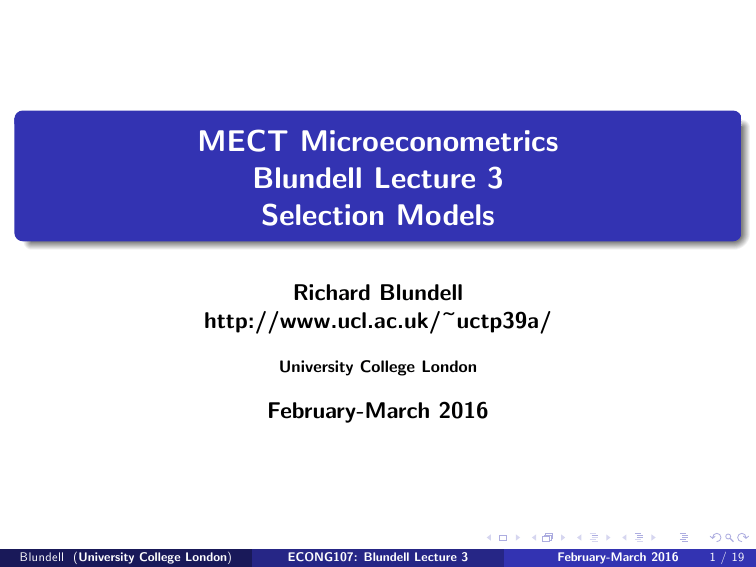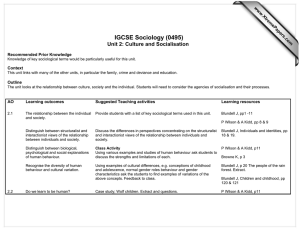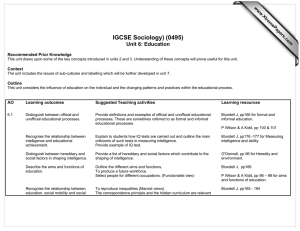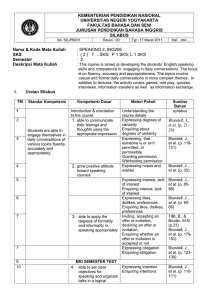MECT Microeconometrics Blundell Lecture 3 Selection Models Richard Blundell
advertisement

MECT Microeconometrics Blundell Lecture 3 Selection Models Richard Blundell http://www.ucl.ac.uk/~uctp39a/ University College London February-March 2016 Blundell (University College London) ECONG107: Blundell Lecture 3 February-March 2016 1 / 19 The Selectivity Model Generalises the censored regression model by specifying mixture of discrete and continuous processes. I Extends the ‘corner solution’model to cover models with …xed costs. I Extends to cover the case of the heterogeneous treatment e¤ect models. Write the latent process for the variable of interest as y1i = x1i0 β1 + u1i with E (u1 jx1 ) = 0. The observation rule for y1 is given by y1i = y1i 0 if y2i > 0 otherwise where y2i = x2i0 β2 + u2i and y2i = 1 if y2i > 0 0 otherwise as in the Probit model. Blundell (University College London) ECONG107: Blundell Lecture 3 February-March 2016 2 / 19 Consider the selected sample with y2i > 0, OLS is biased as we know E (u1i jy2i > 0) = E (u1i jx2i0 β2 + u2i ) = E (u1i ju2i > x2i0 β2 ) 6= 0, if u1 and u2 are correlated. I Suppose to begin with we assume(u1 , u2 ) are jointly normally distributed with mean zero and constant covariance matrix, u1 u2 vN 0 0 , σ11 σ12 σ21 1 . I We can write the orthogonal decomposition of u1 given u2 as u1i = σ12 u2i + ε1i where ε1 is distributed independently of u2 and has a marginal normal distribution. Blundell (University College London) ECONG107: Blundell Lecture 3 February-March 2016 3 / 19 Substituting we have E (u1i jy2i > 0) = E (σ12 u2i + ε1i ju2i > x2i0 β2 ) = σ12 E (u2i ju2i > x2i0 β2 ) + E (ε1i ju2i > = σ12 E (u2i ju2i > x2i0 β2 ) x2i0 β2 ) I From last lecture we have the conditional mean for the truncated normal E (w jw > c ) = = Blundell (University College London) Z ∞ wf (w jw > c )dw 1 σ Φ c c σ h φ φ σc w i∞ =σ σ c 1 Φ ECONG107: Blundell Lecture 3 c σ February-March 2016 4 / 19 Noting that σ22 1, we have E (u1i jy2i > 0) = σ12 E (u2i ju2i > φ ( x2i0 β2 ) = σ12 1 Φ ( x2i0 β2 ) φ (x2i0 β2 ) = σ12 Φ (x2i0 β2 ) = σ12 λ x2i0 β2 . x2i0 β2 ) I In general provided we have this linear index speci…cation E (u1i jy2i > 0) = g x2i0 β2 . I Implying that selection is simply a function of the single index in the selection equation x2i0 β2 , even when joint normality can not be assumed. However, note the restrictiveness of the single linear index speci…cation. Blundell (University College London) ECONG107: Blundell Lecture 3 February-March 2016 5 / 19 I Given this result for the joint normal linear index selection model we can easily derive the familiar Heckman and Maximum Likelihood estimators. The selection model can now be rewritten: y1i = x1i0 β1 + σ12 λ x2i0 β2 + ε1i with E (ε1 jx1 , x2 ) = 0 and E (ε21 jx1 , x2 ) = ω 11 . The observation rule for y1 is given by y1i = y1i 0 if y2i > 0 otherwise where y2i = x2i0 β2 + u2i as before. Blundell (University College London) ECONG107: Blundell Lecture 3 February-March 2016 6 / 19 I We can write the log-likelihood to mirror this conditional speci…cation as and the loglikelihood contribution for observation i is ( ) (y1i x1i0 β1 σ12 λ(x2i0 β2 ))2 1 Di ln p2πω exp + 2ω 11 11 ln li ( β1 , β2 , ω 11 , σ12 ) = Di ln Φ (x2i0 β2 ) + (1 Di ) ln [1 Φ (x2i0 β2 )] ( (y1i x1i0 β1 σ12 λ(x2i0 β2 ))2 N Di ln + ω 11 ln LN ( β1 , β2 , ω 11 , σ12 ) = ∑ 0 Di ln Φ (x2i β2 ) + (1 Di ) ln [1 Φ (x2i0 β2 )] i =1 Notice that β1 , ω 11 , σ12 do not occur in the second part of this expression so there is a natural partition of the loglikelihood into the binary model for selection that estimates β2 and the conditional model on the selected sample. Thus we have the Heckman selectivity estimator or Heckit. Blundell (University College London) ECONG107: Blundell Lecture 3 February-March 2016 7 / 19 I The Heckit estimator is the …rst round of a full MLE estimation which produces consistent but not fully e¢ cient estimators. First estimate β2 by Probit. Then, condition on β2 , estimate β1 , ω 11 , σ12 from the least squares estimation of the conditional model on the selected sample. Can clearly go on to produce the MLE estimators. Stata allows either option. I Note that the LM or Score test can be constructed directly by including λ (x2i0 β2 ) in the selected regression and testing the coe¢ cient. This is a one degree of freedom score test so that a t-test can be used. Blundell (University College London) ECONG107: Blundell Lecture 3 February-March 2016 8 / 19 I Advantages of the Normal Selection Model: (i) avoids the Tobit assumption. (ii) 2-step Heckit estimator is straightforward. (iii) t-test of the null hypothesis H0 : σ12 = 0, i.e. no selectivity bias, can be constructed easily. I Disadvantages: (i) assumes joint normality (ii) need to allow for the estimated β2 in λ (x2i0 β2 ) . Typically easiest to compute full MLE and use the usual formula for correct standard errors. Note that the t-test of selectivity bias can be carried out without this extra computation because the test statistic is valid under the null hypothesis H0 . (iii) need λ (x2i0 β2 ) to vary independently of x1i0 β1 . Blundell (University College London) ECONG107: Blundell Lecture 3 February-March 2016 9 / 19 I The requirement that λ (x2i0 β2 ) varies independently of x1i0 β1 is strictly one of nonparametric identi…cation since, in the parametric joint normal φ (x 0 β ) case for example, λ is a nonlinear function given by Φ(x2i0 β2 ) and is not 2i 2 perfectly collinear with x1i0 β1 even if exactly the same variables are in x1 and x2 . φ (x 0 β ) I However, even in the joint normal case Φ(x2i0 β2 ) can be approximately 2i 2 linear over large ranges of x2i0 β2 . In general, identi…cation requires an exclusion restriction just as in the standard endogenous regressor case. This is really a triangular structure for a simultaneous model. Di is a single endogenous variable in the structural model for y1 . The order condition requires that at least one exogenous variable is excluded for each included rhs endogenous variable. Blundell (University College London) ECONG107: Blundell Lecture 3 February-March 2016 10 / 19 When we are unwilling to assume a parametric distribution for u1 and u2 then the identi…cation arguments becomes even more clear. I As we noted above, given the linear index structure, the selection model can still be written: y1i = x1i0 β1 + g x2i0 β2 + ε1i for y1i observed and with E (ε1 jx1 , x2 ) = 0 and (maybe) E (ε21 jx1 , x2 ) = ω 11 . I But if we do not know the form of g , perfect collinearity can occur if there is no exclusion restriction. Indeed, in general we will need to exclude a continuous ‘instrumental’ variable. I Often this lines up well with the economic problem being addressed. For example, wages and employment. In this case the excluded instrument is nonlabour income. This determines employment but not wages, at least in the static competitive model. Blundell (University College London) ECONG107: Blundell Lecture 3 February-March 2016 11 / 19 Think of other cases: prices …rms set across di¤erent markets, the instrument maybe local costs; occupational choice and earnings? Notice the Tobit structure did not need such an exclusion restriction even when nonlinearity was relaxed. Does selection matter? Empirical examples include Blundell, Reed and Stoker, AER 2003. Try the Mroz data? Does relaxing joint normality matter? Some evidence it does......see the Newey, Powell and Walker AER (1990) and references therein. But need relatively large sample sizes to provide precision in semiparametric extensions. Blundell (University College London) ECONG107: Blundell Lecture 3 February-March 2016 12 / 19 Semiparametric Methods: y1i = x1i0 β1 + g x2i0 β2 + ε1i for y1i observed. two-step methods (analogous to the Heckit estimator) Quasi-maximum likelihood estimators (analogous to Klien-Spady) Blundell (University College London) ECONG107: Blundell Lecture 3 February-March 2016 13 / 19 Semiparametric Methods: (i) Two-Step methods? 1. Estimate β2 , say by maximum score. 2. Estimate β1 , given b β2 . At the second stage there are also a number of possibilities. One attractive approach is simply to use a series approximation to g (x2i0 β2 ) y1i = x1i0 β1 + J ∑ η j ρj j =1 where β2 + e1i x2i0 b ρj x2i0 b β2 = λ x2i0 β2 . x2i0 β2 j 1 e.g. for J = 3, estimate on the selected sample only: y1i = x1i0 β1 + η 1 λ x2i0 b β2 + η 2 λ x2i0 b β2 .x2i0 b β2 +η 2 λ x2i0 b β2 . x2i0 b β2 Blundell (University College London) 2 + e1i . ECONG107: Blundell Lecture 3 February-March 2016 14 / 19 Semiparametric Methods: An alternative is to use Kernel regression. Note that for the selected observations we have a partially (or semi) linear structure: y1i = β10 x1i + g x2i0 β2 + ε1i so that E (y1i jx2i0 β2 ) = β10 E (x1i jx2i0 β2 ) + g x2i0 β2 now subtract the latter expression from the former y1i E (y1i jx2i0 β2 ) = β10 (x1i E (x1i jx2i0 β2 )) + ε1i which no longer depends on g at all! Blundell (University College London) ECONG107: Blundell Lecture 3 February-March 2016 15 / 19 Semiparametric Methods: Suggests an estimator. Starting with: y1i E (y1i jx2i0 β2 ) = β10 (x1i E (x1i jx2i0 β2 )) + ε1i I Replace E (y1i jx2i0 β2 ) and E (x1i jx2i0 β2 ) by their Kernel regression counterparts, then estimate β1 . Note that x2 must contain some excluded continuous instrument otherwise x1i E (x1i jx2i0 β2 ) will be null. I p Newey, Powella and Walker (1990) show that N (b β1 β1 ) N (0, Ω). I They present some results for the Mroz data. Blundell (University College London) ECONG107: Blundell Lecture 3 February-March 2016 16 / 19 Semiparametric Methods: Ahn and Powell (1993) present another similar and very intuitive ’di¤erencing’or ‘matching’style estimator. They note that y1i = x1i0 β1 + g x2i0 β2 + ε1i and consider two observations i and j with x2i0 β2 ‘close’: y1i y1j = (x1i x1j )0 β1 + g x2i0 β2 or y1i y1j = (x1i x1j )0 β1 + (gi g x2j0 β2 + ε1i ε1j gj ) + ε1ij they suggest …nding j observations as close to i as is possible and then eliminate g by regression. They use a Kernel estimator to de…ne observations that are ‘close’. Blundell (University College London) ECONG107: Blundell Lecture 3 February-March 2016 17 / 19 Semiparametric Methods: Key structure for this estimator is: y1i y1j = (x1i x1j )0 β1 + g x2i0 β2 g x2j0 β2 + ε1i ε1j I Note that we can e¤ectively use x2i0 β2 in place of gi or any other monotonic function of x2i0 β2 . I Note also that there is no requirement to have a single(linear) index for the selection rule. Could replace this purely with a ‘propensity score’. That is some selection or assignment equation as a general function of the x2 variables. Blundell (University College London) ECONG107: Blundell Lecture 3 February-March 2016 18 / 19 Alternative Bivariate Models for Selected Samples 1 Double-Hurdle models 2 Infrequency of purchase models Blundell (University College London) ECONG107: Blundell Lecture 3 February-March 2016 19 / 19





